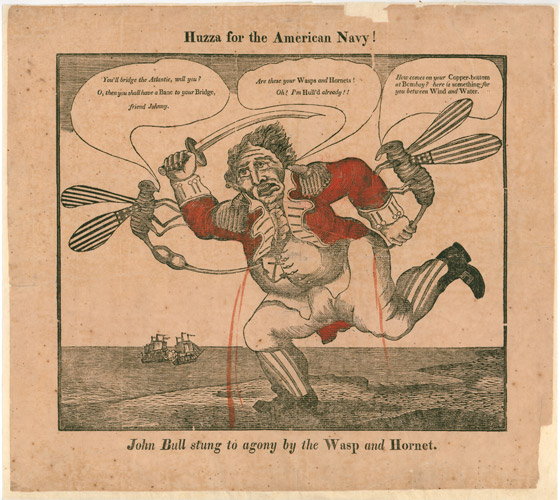By Emilie Haertsch
Humor, like beauty, is in the eye of the beholder. This colorful broadside will be featured in the MHS’s upcoming War of 1812 exhibition, Mr. Madison’s War, which opens on June 18. A broadside such as this would have been posted on the side of a building or kept for home consumption by a patriotic family. In its day, it would have been considered as funny – and meaningful – as our contemporary newspaper’s political cartoons or television news spoofs such as The Colbert Report. But without context, a great deal of this broadside’s wit could be lost to today’s reader.
With the title “Huzza for the American Navy,” the picture features a heavyset man in uniform. Two winged insects sting him on either side as he runs, brandishing his sword, to get away. They are on the beach, and two ships are visible at sea in the background. The caption below reads, “John Bull stung to agony by the Wasp and the Hornet.”
The man is “John Bull,” the personification of Great Britain, and his uniform is hand-painted in scarlet. The “Wasp” and the “Hornet” refer to American ships that won victories over Britain early in the War of 1812. USS Wasp defeated HMS Frolic on October 15, 1812, and USS Hornet sunk HMS Peacock on February 24, 1813.
The first insect says, “You’ll bridge the Atlantic, won’t you? Oh then you’ll have a Bane to your Bridge, friend Johnny.” The use of “Bane” and “Bridge” refers to William Bainbridge, who was captain of USS Constitution when it captured HMS Java on December 29, 1812.
John Bull replies, “Are these your Wasps and Hornets! Oh! I’m Hull’d already!!” “Hull” was Isaac Hull, who commanded USS Constitution during an earlier cruise when it defeated HMS Guerrière on August 19, 1812.
The second insect says, “How comes on your Copper-bottom at Bombay? Here is something for you between Wind and Water.” “Copper-bottom at Bombay” appears to be a taunt. When the Constitution defeated and then destroyed the Java off the coast of Brazil, the Royal Navy frigate was transporting the new commander-in-chief of British forces in India, Sir Thomas Hislop, to Bombay, along with copper to sheath the hull of a new 74-gun ship. Copper sheathing prevented a ship from being slowed by marine growth on its hull over the course of a long voyage. The loss of the Java and its cargo of copper delayed the completion of HMS Cornwallis.
“Between Wind and Water” denotes the way sailing ships engaged in battle. They aimed their cannons for the opponent vessel’s waterline, to “hull” it. A hit there was likely to do the most damage because a ship’s waterline rose and fell as wind and waves rocked the ship. But it also works as a double entendre, with the insect stinging John Bull between where he created “wind” and “water – as does the word “Bombay.”
Although this broadside has no inscription, due to the timely nature of its content it likely was printed in March or April of 1813, soon after the Hornet returned from its victory over the Peacock off of the coast of Guyana. The Hornet anchored at Holmes’ Hole in Martha’s Vineyard on March 19, 1813.
Some of the jokes hidden inside this broadside we will likely never know, but a little bit of context provides insight not just into the events of the war but also into what made Americans laugh in 1813, when the pun was the epitome of wit.
To see more documents from the Society’s collections related to the war, as well as more information about our upcoming exhibition and other planned events in the Boston area, please visit our War of 1812 web feature.



